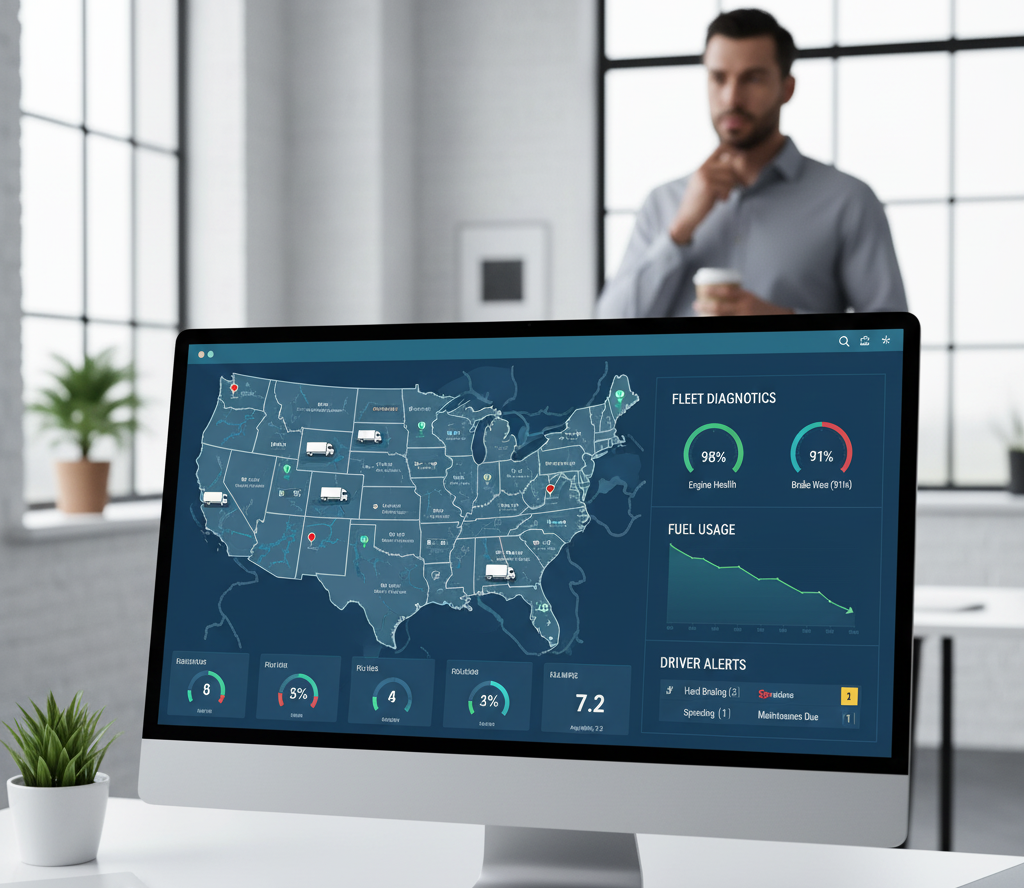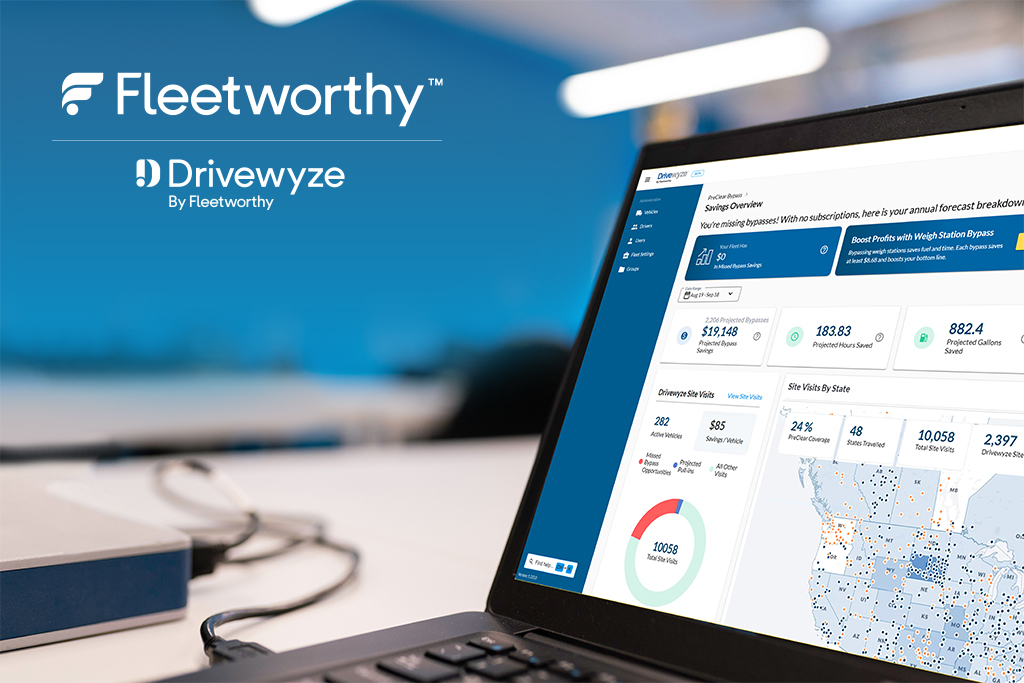At its core, fleet telematics refers to the use of telecommunications and informatics to monitor and manage fleets through GPS tracking, sensors, onboard diagnostics, and cloud-based data platforms. By collecting, transmitting, and analyzing data from vehicles and equipment, fleet telematics systems empower fleet managers to make smarter, faster, and more informed decisions.
The growing adoption of telematics across industries isn’t just about technology, it’s about transforming the way fleets operate. One of the most significant outcomes of integrating telematics is increased operational visibility. With accurate, real-time data on vehicle location, driver behavior, fuel consumption, and maintenance needs, fleet managers gain the transparency they need to identify inefficiencies, reduce risks, and boost overall productivity. Operational visibility also plays a crucial role in regulatory compliance, customer service, and proactive safety management three areas that directly impact a fleet’s bottom line.
In this article, we’ll explore:
- What fleet telematics systems are and how they function,
- The role of telematics in fleet management and its core benefits,
- Key integration strategies to unlock full visibility and efficiency,
- A focused look at the role of telematics in construction fleet management, and
- Common challenges and future trends shaping the telematics landscape.
Whether you manage a long-haul trucking fleet, construction vehicles, or a mixed-asset operation, understanding how to integrate telematics effectively is essential to staying competitive and compliant in today’s data-driven environment.
Understanding Fleet Telematics
A fleet telematics system is a technology platform that combines GPS tracking, vehicle diagnostics, wireless communication, and cloud-based data analytics to collect and transmit real-time information from fleet vehicles to a centralized management system. These systems serve as the digital nervous system of modern fleets, enabling constant connectivity between vehicles, drivers, and fleet operators.
Telematics systems typically consist of onboard devices installed in vehicles, which interface with various sensors and the vehicle’s engine control unit (ECU). These devices gather data points such as location, speed, idling time, engine health, braking patterns, and more delivering insights that help fleet managers optimize operations and maintain compliance.
How It Works: From Data Collection to Decision-Making
At a technical level, fleet telematics operates through an interconnected network of components:
- GPS Modules provide precise location tracking and route data.
- Vehicle Sensors monitor engine performance, fuel levels, tire pressure, and more.
- Onboard Diagnostics (OBD-II or CAN Bus) feed real-time vehicle health information.
- Wireless Networks (4G/5G/Satellite) transmit this data to cloud servers.
- Cloud-based platforms aggregate and analyze data, turning it into actionable insights through dashboards, alerts, and reports.
This end-to-end system ensures that fleet operators are never in the dark about where their assets are, how they’re performing, or what might need attention laying the groundwork for advanced capabilities like predictive maintenance and behavior-based safety programs.
The Role of Telematics in Fleet Management
Modern fleet operations are increasingly complex, requiring real-time coordination of vehicles, drivers, routes, maintenance schedules, and compliance requirements. This is where telematics for fleet management plays a crucial role, providing the tools and data-driven insights necessary to manage these moving parts efficiently and safely. Below are four essential areas where telematics transforms fleet performance and visibility.
Enhancing Real-Time Vehicle Tracking
One of the most immediate and impactful benefits of telematics and fleet management is precise, real-time vehicle tracking. Using GPS-enabled telematics devices, fleet managers can see the exact location, movement, and status of every vehicle in their fleet at any given moment. This visibility supports:
- Proactive dispatching and rerouting in response to delays or emergencies
- Faster customer updates and service verification
- Improved theft prevention and asset recovery
Beyond logistics, live tracking contributes to accountability and helps enforce route compliance, time management, and service-level agreements (SLAs).
Monitoring Driver Behavior and Safety
Telematics systems provide detailed insights into driver behavior, including speed, acceleration, braking, idling, and even harsh cornering. This data can be used to:
- Identify high-risk driving habits before they result in incidents
- Deliver targeted driver coaching and safety training
- Develop performance-based incentives that reward safe driving
This monitoring is crucial to establishing a culture of safety and accountability, particularly in high-risk sectors such as delivery, transit, and construction. By linking driver behavior metrics with incident records, fleets can significantly reduce their accident rates and insurance exposure.
Fuel Usage Optimization and Route Planning
Fuel is often one of the most significant operational costs for fleets. Telematics helps optimize fuel efficiency by providing granular data on:
- Idle time and excessive acceleration
- Unnecessary detours or inefficient routes
- Fuel-wasting behaviors such as speeding or aggressive driving
With historical route data and predictive modeling, telematics for fleet management enables more innovative route planning, minimizing travel distance, avoiding congestion, and improving on-time performance while lowering fuel spend.
Maintenance Alerts and Downtime Reduction
Proactive maintenance is essential for fleet reliability and safety. Telematics systems connect directly to vehicle diagnostics, generating real-time alerts for:
- Engine faults or warning codes
- Scheduled maintenance reminders based on mileage or engine hours
- Unexpected mechanical issues that could lead to roadside breakdowns
By acting on this data promptly, fleet managers can prevent costly repairs and minimize vehicle downtime. This shift from reactive to preventive maintenance enhances uptime, prolongs vehicle life, and facilitates regulatory compliance for roadworthiness.
Integration Strategies for Maximum Visibility
To unlock the full potential of a fleet telematics system, integration is key. While telematics alone delivers valuable insights, true operational visibility is only achieved when telematics data is connected to the broader digital ecosystem within your fleet. The following strategies outline how to integrate telematics effectively to drive visibility, efficiency, and long-term value.
Aligning Telematics Data with Fleet Management Software
Integrating telematics data into your existing fleet management software (FMS) creates a centralized source of truth for decision-making. By combining location, diagnostics, and driver behavior data with routing, scheduling, and dispatch systems, fleets gain a 360-degree view of operations.
This alignment allows you to:
- Track vehicle utilization in real time
- Compare planned vs. actual routes
- Generate exception reports based on pre-defined thresholds
- Automate compliance documentation (e.g., HOS, DVIRs)
When integrated properly, telematics and fleet management systems work together to eliminate data silos and support faster, smarter responses to dynamic operational needs.
Centralizing Dashboards for Unified Operational Control
Fragmented data equals fragmented decision-making. One of the most effective integration strategies is to centralize telematics data on unified dashboards accessible across departments and leadership levels.
Centralized dashboards provide:
- Real-time operational snapshots
- Visual KPIs across safety, performance, and maintenance
- Custom alerts for violations or anomalies
- Drill-down capabilities for individual vehicles or drivers
This visibility enables cross-functional collaboration and empowers managers to act on trends, not just individual incidents.
Integrating Telematics with Maintenance Scheduling Systems
Maintenance planning becomes significantly more powerful when driven by real-world telematics data. By integrating your fleet telematics system with digital maintenance platforms, you can automate scheduling based on:
- Actual mileage or engine hours (vs. static schedules)
- Diagnostic fault codes and wear indicators
- Utilization patterns across vehicles and asset types
This connection enables predictive maintenance, reducing unplanned downtime, minimizing over-maintenance, and ensuring vehicles remain compliant and road-ready.
Leveraging APIs and Middleware for Smooth Data Exchange
Integration doesn’t always mean ripping and replacing systems. With modern APIs and middleware tools, telematics data can be securely shared across platforms and departments without disrupting existing workflows.
Using APIs, fleets can:
- Feed telematics data into HR systems for performance reviews
- Sync location data with TMS platforms for real-time delivery tracking
- Share maintenance alerts with third-party vendors for faster response times
This approach ensures your telematics and fleet management tools remain agile, scalable, and compatible with future tech investments.
Best Practices for Integration Success
A successful telematics integration strategy is more than a technical implementation, it’s an organizational shift. To ensure success, fleets should:
Set Clear KPIs
Define measurable goals before integration begins. Common metrics include:
- Accidents per million miles
- Idle time per driver
- Average repair turnaround
- Fuel cost per mile
These KPIs serve as benchmarks for evaluating the ROI of your integrated system.
Ensure Cross-Department Collaboration
Involve stakeholders from operations, safety, IT, HR, and maintenance at an early stage in the process. This ensures all data touchpoints are accounted for and everyone understands how to use the system post-deployment.
Use Scalable Platforms for Future-Proofing
Select platforms that support API integrations, remote updates, and modular feature expansion. A scalable fleet telematics system allows your tech stack to evolve as your fleet grows or regulations change.
Overcoming Common Integration Challenges
While the benefits of fleet telematics are substantial, successful integration is not without its challenges. From data silos to user resistance, fleets must navigate several obstacles when embedding telematics systems into their operations. Understanding these barriers and planning for them early can make the difference between a frustrating rollout and a smooth, high-impact transformation.
Data Silos and Incompatible Platforms
One of the most common barriers to effective telematics integration is the existence of disconnected systems. Many fleets rely on multiple software platforms each responsible for a different aspect of operations, such as dispatching, maintenance, compliance, or payroll. If these systems can’t share data seamlessly, it leads to fragmentation, redundant work, and inconsistent reporting.
Overcoming this challenge often requires a deliberate investment in open, API-enabled solutions or middleware that bridges the gap between platforms. Fleets should assess their current tech stack and choose telematics providers that offer strong integration capabilities with existing software. The goal is to create a centralized ecosystem where data flows automatically, supporting smarter and faster decision-making.
Driver Resistance and Change Management
Even the most advanced telematics system can fall short if drivers aren’t on board. Concerns around privacy, micromanagement, and added workload are common among drivers when new monitoring technologies are introduced. Without proper communication, the rollout of telematics can be met with skepticism or outright pushback.
Successful change management starts with transparency. Fleet managers should clearly explain the purpose of telematics, emphasizing benefits like improved safety, reduced downtime, and fairer performance assessments. Involving drivers early, offering training, and reinforcing how the data will be used (and what it won’t be used for) helps build trust. Some fleets also find success in linking safe-driving incentives to telematics data, transforming resistance into engagement.
Privacy and Cybersecurity Concerns
As telematics systems collect vast amounts of sensitive data from driver behavior to location tracking and vehicle diagnostics, they can become targets for cyber threats if not properly secured. Additionally, regulatory expectations regarding data privacy are increasing, particularly when employee tracking is involved.
To address these concerns, fleets must work with telematics providers that prioritize data protection. Encryption, secure user authentication, and compliance with standards such as ISO 27001 or SOC 2 are non-negotiable requirements. Internally, fleets should implement data governance policies that define who has access to what data and under what circumstances. Protecting this information is not just a technical issu,e it’s a reputational one.
Training and Support Requirements
Integrating a fleet telematics system is not a plug-and-play process. It requires upfront training, ongoing education, and often a shift in day-to-day workflows. Operators, dispatchers, maintenance teams, and executives all need to understand how to interpret and act on the data being generated.
This learning curve can be steep, especially for fleets transitioning from manual or legacy systems. Selecting a vendor that offers comprehensive onboarding, user-friendly dashboards, and ongoing support is crucial. Beyond initial training, fleets should foster a culture of continuous improvement by utilizing telematics data in team meetings, performance reviews, and strategic planning.
Conclusion
The integration of fleet telematics into daily operations is no longer a competitive advantage; it’s a fundamental requirement for modern fleet management. From real-time tracking and driver behavior monitoring to predictive maintenance and sustainability insights, telematics delivers the visibility and control fleet operators need to reduce risk, improve performance, and stay compliant in a rapidly evolving industry.
However, realizing the full value of telematics requires more than just installing hardware or software. It demands strategic planning, cross-functional alignment, and a commitment to continuous improvement. Fleets that take the time to integrate telematics data across departments, operations, safety, maintenance, and compliance gain a powerful decision-making engine that drives long-term success.
If you haven’t already started, now is the time to act. Begin with a pilot program to evaluate platforms and assess organizational readiness. Conduct a technology audit to identify gaps in your current systems. And don’t hesitate to consult with experienced telematics providers who can tailor solutions to your specific needs and goals. The sooner you integrate, the sooner you gain the insights and agility needed to lead your fleet into the future.
Frequently Asked Questions (FAQs)
What is a fleet telematics system?
A fleet telematics system is a technology platform that utilizes GPS tracking, sensors, and data analytics to monitor vehicle performance, driver behavior, and asset location in real-time. It enables fleet managers to make data-driven decisions that improve efficiency, safety, and compliance.
How does telematics help with fleet management?
Telematics for fleet management provides visibility into key metrics such as fuel usage, route efficiency, vehicle maintenance, and driver safety. By integrating telematics with fleet management software, companies can streamline operations, reduce costs, and proactively address issues before they escalate.
What are the benefits of integrating telematics with other fleet systems?
Integrating a fleet telematics system with maintenance, dispatch, HR, and compliance tools allows for unified data management and automated workflows. This reduces manual reporting, improves cross-department coordination, and enhances operational visibility across the organization.
Are there privacy concerns with telematics systems?
While telematics collects sensitive data, such as driver behavior and vehicle location, reputable providers follow strict cybersecurity protocols and adhere to relevant privacy regulations. Clear internal policies and transparent communication with drivers are crucial for building trust and ensuring compliance.




